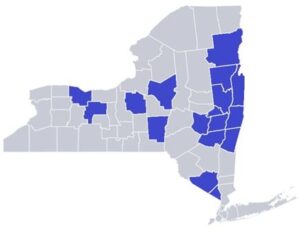Methods Report for COVID Response Study Now Available
By, Aaron Leo, Jessie Tobin, Maria Khan, and Kristen C. Wilcox
NYKids recently finished the first phase of our study entitled “Discovering Impacts of the COVID-19 Pandemic on the Education Workforce” in which we surveyed over 900 educators across New York State. Although our team is still analyzing the results, we have already reported on some of the major findings in previous blogs.
We are pleased to announce that the full Methods and Procedures Report is now available on our website. In this blog we review some of the main details about the development, recruitment, and methods and procedures used in the analysis of our survey and reporting findings.
Background
 The idea for this project began as our team – like most across the world – watched the spread of a pandemic that still, nearly two years on, has not fully abated. We noted that among all the research which justifiably focused on the impacts on youth, there was less attention being paid to the educator workforce. We felt that an in-depth survey of educators’ experiences across the state could help fill in this gap.
The idea for this project began as our team – like most across the world – watched the spread of a pandemic that still, nearly two years on, has not fully abated. We noted that among all the research which justifiably focused on the impacts on youth, there was less attention being paid to the educator workforce. We felt that an in-depth survey of educators’ experiences across the state could help fill in this gap.
Theoretical Framing
We drew on several theoretical frameworks to guide the development of this study. For one, we drew on research which emphasized the impacts of stress and secondary trauma that educators may experience in the workplace. Second, we used the theory of performance adaptation as a lens through which we can understand how organizations and people working within them adapt to new requirements and changing conditions. Lastly, we referred to social-ecological theory to situate the impacts of the pandemic and people’s responses to it within the immediate (classrooms, schools) and more distal (community, region) contexts in which educators lived and worked during this time period.
Research Questions and Goals
Our main aims for this study were to explore educator stress, job satisfaction, and performance adaptations in the context of the first year of the COVID-19 pandemic. We also sought to identify the extent and character of secondary traumatic stress educators experienced during this time as a result of increased needs of students and families.
From this literature and theoretical framing, we developed the following research questions:
- To what extent and how do school leaders and teachers experience stress in response to COVID-19 disruptions?
- To what extent and how do school leaders and teachers indicate a change in job satisfaction in response to COVID-19 disruptions?
- To what extent and how do school leaders and teachers indicate changes in their work or personal life in response to COVID-19 disruptions?
For each of these questions, we sought to understand how school and community characteristics might have impacted the experiences of educators and their responses to the pandemic.
Sample Selection and Recruitment
The survey population targeted for this study was instructional staff and school support professionals (e.g., social workers, school psychologists, counselors) in all New York state P-12 schools. In order to disseminate our survey to as many schools throughout New York State as possible, NYKids partnered with the School Administrators Association of New York State (SAANYS). With SAANYS’ help, 38 schools ended up participating in this research project with the total number of responses reaching 904.

Follow-up interviews were conducted with a select group of school principals and other school leader designees such as assistant principals or COVID coordinators. The research team identified schools that qualified as positive outliers (i.e., exhibiting unusually more positive workforce responses with regard to stress, job satisfaction, and performance adaptation) for a second phase of study.
Data Collection
The survey questions covered several lines of inquiry that included: facilitators for performance adaptation – cognitive, behavioral, and affective; working conditions related to organizational and contextual forces, factors, and actors; occupational stress (e.g., negative stress and eustress [positive]); life-work relations and balance.
A final set of questions captured respondents’ demographics to help our research team compare the way educators from different backgrounds and family situations experienced the first year of COVID-19. The last question was an open-ended response where educators could add any other thoughts they had regarding instruction during the pandemic.
This study included two major sources of data to respond to the research questions:
- educator (teachers, teaching assistants, school psychologists, social workers, and counselors) surveys
- interviews with school leaders

Data Analysis
To analyze the quantitative data, survey responses were analyzed in a statistical program (SPSS).
Educators’ responses to the open-ended survey questions complemented the quantitative analysis. Of the 904 survey respondents, 314 participants left responses to the open-ended question. The open-ended survey responses were analyzed using NVivo 12 qualitative data analysis software.
The full Methods Report is now available to read on our website as well as other research highlighting the preliminary findings of our study.
Please continue to follow our blog posts for the latest news related to NYKids research and projects. As always, we thank you for your interest in NYKids and encourage you to reach out to nykids@albany.edu for further insights and direct support needs.
Tag:COVID-19, methodology, research, survey
